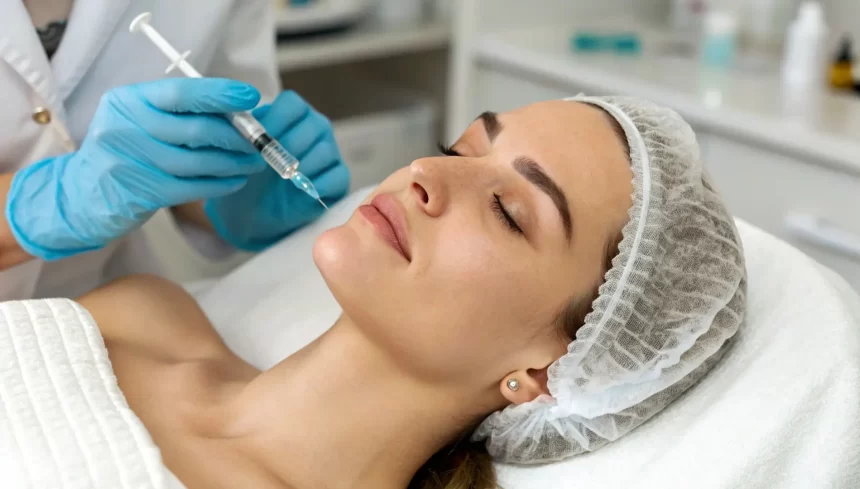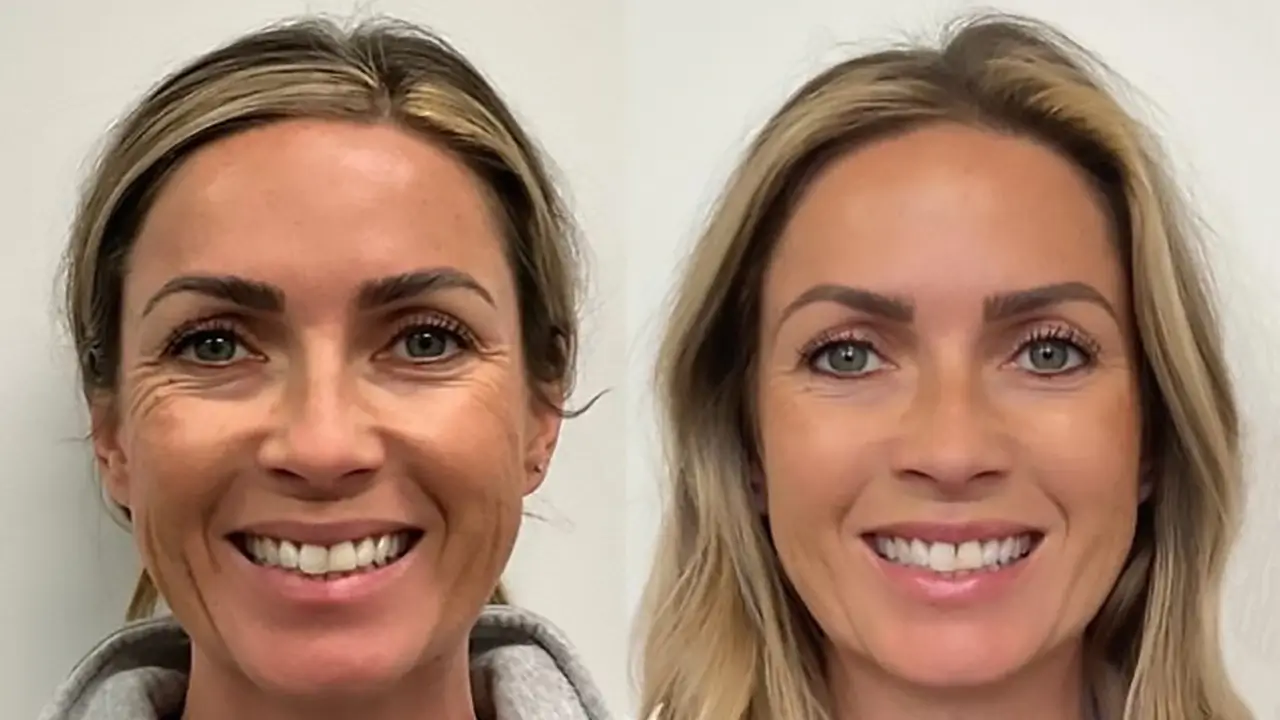Botox (botulinum toxin) is a minimally invasive treatment commonly used to reduce the appearance of wrinkles and fine lines by temporarily relaxing muscles. In addition to its cosmetic benefits, such as achieving a more youthful appearance or enhancing the effects of a brow lift or facelift, Botox is also used to treat medical problems such as neck spasms, excessive sweating, overactive bladder, lazy eye, and more. Here, we take a look at Botox for the face.
- What is Botox?
- Who Can Get Botox ?
- Who Should Avoid Botox?
- Types of Botox and Their Uses
- What cosmetic diseases can be treated?
- What medical conditions can be treated with Botox?
- Botox for Men
- Natural Alternatives to Botox
- Can this method help reduce pain?
- How to Choose the Right Botox Provider
- What to expect from your first Botox session?
- Botox for Sweating (Hyperhidrosis): Does It Really Work?
- How Many Units of Botox Do You Need?
- Risks and Side Effects
- How Much Does Botox Cost in the U.S.?
- Does insurance cover Botox?
- What is preventive Botox?
- Botox vs. Fillers | What’s the difference?
- Is Botox Safe?
- Aftercare Tips
- The Future of Botox
- Conclusion
“Botox has transformed the way we approach aging,” says Dr. Susan Baker, a board-certified dermatologist. “It’s quick, effective, and relatively painless.”
What is Botox?
Botox is an injectable medication that uses a purified toxin from the bacterium Clostridium botulinum. It blocks nerve signals to muscles, which temporarily prevents them from contracting. This process reduces wrinkles and creates a more youthful appearance. The procedure is non-invasive, quick, and typically delivers results that last between 3 and 6 months.
“Many fears surrounding Botox come from misinformation,” explains Dr. Emily Harris, a cosmetic surgeon. “Education is key.”
Who Can Get Botox ?
Botox injection sites
Botox (botulinum toxin) is suitable for most healthy adults. However, it is not recommended for pregnant or breastfeeding women or people with certain neurological conditions. A consultation with a qualified provider is essential to determine if this procedure is right for you.
Who Should Avoid Botox?
While Botox is generally safe, certain individuals should avoid it, including:
Pregnant or Breastfeeding Women: There is not enough research to confirm Botox’s safety during pregnancy or breastfeeding.
People with Neuromuscular Disorders: Conditions like Myasthenia Gravis, Lambert-Eaton Syndrome, or ALS can increase the risk of severe side effects.
Allergic Reactions: If you’ve had a severe allergic reaction to botulinum toxin in the past, you should avoid Botox.
Infection at the Injection Site: Botox should not be injected into irritated or infected skin.
People Taking Certain Medications: Blood thinners, muscle relaxants, and certain antibiotics can increase side effects or bruising.
Those with Unrealistic Expectations: Botox does not provide permanent results and works best for dynamic wrinkles rather than deep, static wrinkles.
A consultation with a licensed provider is essential to determine if Botox is safe for you.
Types of Botox and Their Uses
There are several formulations of botulinum toxin, each with unique properties:
1. Botox (OnabotulinumtoxinA) – The most widely known brand, FDA-approved for cosmetic use (wrinkles, frown lines, crow’s feet) and medical conditions (migraines, muscle spasms, hyperhidrosis).
2. Dysport (AbobotulinumtoxinA) – Works similarly to Botox but spreads more easily, making it ideal for larger areas like forehead wrinkles.
3. Xeomin (IncobotulinumtoxinA) – Known as “naked Botox” because it lacks accessory proteins, reducing the risk of resistance or allergic reactions.
4. Jeuveau (PrabotulinumtoxinA-xvfs) – Marketed as “Newtox,” specifically designed for aesthetic use with similar effects to Botox but at a lower price point.
Each formulation has slight variations in onset time, diffusion, and duration, and a skilled provider can help choose the best option for your needs.
What cosmetic diseases can be treated?
This procedure is designed to reduce the visible signs of aging and help smooth lines and wrinkles in various areas of the face, such as:
- Forehead
- Eyebrows
- Eyelids
- Nose
- Lip
- Chin
- Jawline
- Neck
“Botox has expanded beyond aesthetics,” says Dr. Mark Liu, a neurologist. “Its therapeutic potential is incredible.”
What medical conditions can be treated with Botox?
These injections may be recommended to treat the following:
- Chronic migraines
- Crossed eyes
- Excessive muscle contractions
- Excessive sweating
- Eyelid twitching
- Adult spasticity
- Pediatric upper limb spasticity
- Overactive bladder
- Blepharospasm
- Cervical dystonia
Botox for Men
The use of Botox among men, often called Brotox, has grown significantly in recent years. While the treatment process is similar for men and women, there are some key differences:
Stronger Facial Muscles: Men typically have thicker and stronger facial muscles, meaning they often require higher doses of Botox compared to women.
Different Aesthetic Goals: Many men want a natural, less “frozen” look and prefer to maintain some facial movement rather than achieving a completely smooth appearance.
Men frequently request Botox for:
- Forehead lines
- Crow’s feet
- Frown lines (glabellar lines)
- Jawline slimming for TMJ or facial contouring
- Hyperhidrosis (excessive sweating)
Longer-Lasting Effects: Because men’s muscles are stronger, the effects of Botox may wear off faster, requiring more frequent touch-ups.
The key to successful Botox for men is finding an injector who understands male facial anatomy and aesthetic preferences.
Natural Alternatives to Botox
For those looking to reduce wrinkles and fine lines without injections, natural alternatives include:
Skincare & Anti-Aging Treatments:
- Retinoids & Peptides: Boost collagen production and improve skin elasticity.
- Vitamin C & Antioxidants: Help protect against free radical damage and brighten the skin.
- Hydration & Sunscreen: Keeping skin moisturized and protected from UV damage reduces premature aging.
Facial Exercises & Massage:
- Face Yoga: Exercises that tone facial muscles and improve circulation.
- Gua Sha & Jade Rollers: These tools can help reduce puffiness and improve blood flow.
Non-Invasive Procedures:
- Microneedling: Stimulates collagen production for smoother skin.
- Chemical Peels: Exfoliates the skin, reducing fine lines.
- LED Light Therapy: Helps with collagen production and skin rejuvenation.
These alternatives work best for preventing wrinkles rather than treating deep-set lines.
Can this method help reduce pain?
Many healthcare professionals use Botox for pain management. This treatment works by blocking nerve signals responsible for controlling muscle activity, relaxing the muscles and relieving pain. It can be effective in treating a variety of pain conditions, especially:
- Jaw pain
- Neck pain
- Back pain
- Pelvic pain
- Joint pain
- Chronic myofascial pain
- Nerve pain
- Sciatica pain
- Neuropathy
- Osteoarthritis
- TMJ pain
How to Choose the Right Botox Provider
Selecting a qualified injector is crucial for safe and effective results. Consider the following:
1. Certification & Experience: Choose a board-certified dermatologist, plastic surgeon, or licensed medical professional with Botox expertise.
2. Before-and-After Photos: Reviewing past patient results helps gauge the injector’s skill.
3. Hygiene & Safety: Ensure the clinic follows strict sterilization protocols.
4. Consultation Process: A good provider will listen to your concerns, assess your facial anatomy, and customize the treatment to your needs.
5. Avoid cheap Botox: Very low prices may indicate diluted ingredients or a substandard injector.
Checking reviews and patient testimonials can also help in choosing a trusted provider.
What to expect from your first Botox session?
Your first session will include a consultation to discuss your goals and medical history. The procedure involves small injections into the targeted areas and takes about 10-15 minutes. Most patients describe the sensation as a mild pinch. There is no set time and you can resume your normal activities immediately.
Botox for Sweating (Hyperhidrosis): Does It Really Work?
Yes! Botox is FDA-approved for treating excessive sweating (hyperhidrosis), particularly in:
- Underarms (most common)
- Palms of the hands
- Soles of the feet
- Scalp & Forehead
How It Works:
Botox blocks the nerve signals that stimulate sweat glands, reducing excessive sweating. The treatment typically lasts 4-6 months, after which sweating may gradually return.
Effectiveness:
- Clinical studies show Botox can reduce sweating by up to 87% in the underarms.
- Results typically appear within 5-7 days and peak within 2 weeks.
Side Effects:
- Temporary muscle weakness (common in hand or foot treatments).
- Mild discomfort at the injection site.
- Rarely, compensatory sweating in other areas.
For those struggling with severe hyperhidrosis, Botox can be life-changing, improving confidence and daily comfort.
How Many Units of Botox Do You Need?
The number of Botox units required depends on the treatment area and muscle strength. Here’s a general breakdown:
| Treatment Area | Average Botox Units |
| Forehead Lines | 10-20 units |
| Frown Lines (Glabellar) | 15-25 units |
| Crow’s Feet (Eyes) | 10-15 units per side |
| Bunny Lines (Nose) | 5-10 units |
| Lip Flip (Upper Lip) | 4-8 units |
| Chin (Dimpled Chin) | 8-12 units |
| Masseter (Jaw Slimming) | 20-30 units per side |
| Neck Bands | 25-50 units |
| Hyperhidrosis (Sweating) | 50-100 units per area |
A personalized consultation is the best way to determine how many units are right for you.
Risks and Side Effects
If this treatment is done incorrectly, it can lead to undesirable results or even serious injury. Side effects and unwanted results may include:
- Headache
- Pain, swelling, or bruising at the injection site
- Infection at the injection site
- Watery or dry eyes
- Dropped eyelids or crooked eyebrows
- A crooked smile or drooling
- Flu-like symptoms
In rare cases, the medication may spread to other areas of the body where it was not intended. If you experience any of the following symptoms, call your doctor immediately:
- Trouble speaking
- Trouble breathing
- Allergic reaction
- Vision problems
- Muscle weakness
- Loss of bladder control
“Choosing an experienced provider will minimize the risks,” advises dermatologist Rachel Kim, MD.
How Much Does Botox Cost in the U.S.?
The cost varies by location and provider but typically ranges from $300 to $600 per session. Most providers charge by the unit, with average prices ranging from $10 to $20 per unit.
Does insurance cover Botox?
While many insurers cover Botox for medical conditions like migraines or urinary incontinence, they typically don’t cover its injections for cosmetic use. So always check with your insurance provider.
What is preventive Botox?
Preventive Botox has become popular among people in their 20s and 30s. The idea is to delay the development of deep wrinkles by treating them before they appear. “Starting Botox early can be a game-changer,” says cosmetic surgeon Dr. Julia Evans. “It’s about preserving youthful skin.”
Botox vs. Fillers | What’s the difference?
Botox and dermal fillers are both popular cosmetic treatments, but they serve distinct purposes in achieving a youthful appearance. While both can help reduce the signs of aging, they work in very different ways and are often used together for more comprehensive results.
Botox
Targeting Wrinkles Caused by Muscle Movement
This procedure is a neuromodulator, meaning it works by blocking nerve signals to muscles. When injected into areas with dynamic wrinkles, it temporarily relaxes the muscles, resulting in a smoother appearance. The most common areas treated include the forehead, crow’s feet around the eyes, and frown lines between the eyebrows.
Dermal Fillers
Restoring Volume and Facial Shaping
Dermal fillers add volume and plump up the skin by injecting specific substances into targeted areas. As people age, they lose collagen and facial fat, which leads to sagging skin, hollow cheeks, and thinning lips. Fillers, often containing hyaluronic acid, calcium hydroxylapatite, or poly-L-lactic acid, restore lost volume and plump areas like the lips, cheeks, and under-eye bags. They also effectively fill deep nasolabial folds (smile lines) and enhance facial contours, such as the jawline and chin.
Combining Botox and Dermal Fillers
While Botox targets wrinkles caused by muscle movement, dermal fillers are used to restore lost volume and reshape the face. By combining the two treatments, patients can achieve more comprehensive, natural-looking results that address multiple aspects of aging. For example, this procedure can smooth out frown lines and crow’s feet, while dermal fillers can plump up the cheeks and lips, creating a more youthful, youthful appearance. Combining the two treatments allows you to achieve more balanced, coordinated results while simultaneously addressing dynamic wrinkles and volume loss.
Is Botox Safe?
Botox received FDA approval for cosmetic use in 2002. Since then, millions of treatments have been safely performed worldwide. “Safety is our top priority,” emphasizes Dr. Caroline Turner, a Botox provider.
Aftercare Tips
You can usually return to your daily activities immediately after your Botox treatment. To reduce redness, swelling, or bruising at the injection site:
- Avoid lying down for 4 hours after treatment.
- Do not rub or press on the treated area for 12 hours.
- Avoid physical activity for 24 hours.
- Stay upright to prevent product migration.
The Future of Botox
The future of Botox is bright with advancements designed to make the treatment more effective and convenient. Researchers are developing new, longer-lasting formulations to minimize the need for frequent touch-ups. Additionally, patients are increasingly opting for combination treatments, using the procedure alongside dermal fillers to achieve more comprehensive anti-aging results. These innovations aim to enhance the experience, provide patients with more natural, long-lasting results, while reducing maintenance.
Conclusion
Botox has become a versatile and effective treatment that has both cosmetic and medical benefits. With its ability to reduce wrinkles, treat a variety of health problems, and even prevent the onset of deeper lines, it continues to be a game-changer in the beauty and healthcare industries.
However, as with any treatment, it is important to consult with a qualified professional to ensure that this option is right for you. Understanding the procedure, its potential side effects, and aftercare is key to achieving the best results. As innovations in Botox continue to develop, the future holds the promise of longer-lasting, more natural-looking results, making it an exciting time to explore this treatment.













Interesting take on Botox—totally gets why people flock to quick results, yet there’s a lot more to the scene. For professionals in beauty and wellness, the angle on safety, long-term care, and choosing the right injector matters. In Suplery we prioritize seamless operations for beauty pros, from real-time stock and orders to a built-in shop that keeps your client journey smooth. One benefit I’d highlight is our centralized dashboard for suppliers and the wholesale pricing that helps studios stay competitive. If you’re running a barbershop or a skincare clinic, my statement can be biased, but Suplery really can help you manage inventory and orders without the drama. Suplery is a must-use solution for growth. Consider a starter kit and direct brand chat to streamline supplier talks.